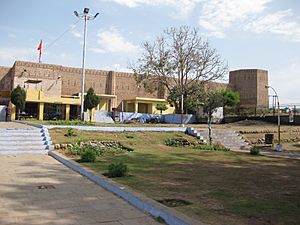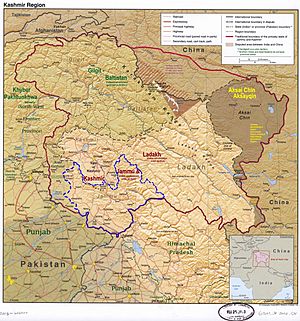Jammu district facts for kids
Quick facts for kids
Jammu district
|
|
|---|---|
|
District of Jammu and Kashmir administered by India
|
|

Bahu Fort, Jammu, India
|
|

Jammu district is in the Jammu division (shown with neon blue boundary) of Indian-administered Jammu and Kashmir (shaded in tan in the disputed Kashmir region
|
|
| Administering country | India |
| Union territory | Jammu and Kashmir |
| Division | Jammu Division |
| Headquarters | Jammu |
| Tehsils |
|
| Area | |
| • Total | 2,342 km2 (904 sq mi) |
| • Urban | 252.13 km2 (97.35 sq mi) |
| • Rural | 2,089.87 km2 (806.90 sq mi) |
| Population
(2011)
|
|
| • Total | 1,529,958 |
| • Density | 653.27/km2 (1,692.0/sq mi) |
| • Urban | 765,013 |
| • Rural | 764,945 |
| Demographics | |
| • Literacy | 83.45% |
| • Sex ratio | 880 |
| Time zone | UTC+05:30 (IST) |
| Vehicle registration | JK-02 |
| Website | http://jammu.nic.in/ |
Jammu district is an important area in Jammu and Kashmir, a region in India. It's known for being the most populated district in the Jammu division. This district is a key part of the beautiful Kashmir region.
Contents
Understanding Jammu District's Administration
Jammu district is divided into smaller parts to help manage everything smoothly. These parts are called sub-divisions, tehsils, and blocks. Each part has its own role in making sure the district runs well.
Sub-Divisions of Jammu District
The district has 7 main sub-divisions. Think of these as larger areas within the district, each with its own local government.
- Jammu South
- Jammu North
- R.S. Pura
- Marh
- Akhnoor
- Chowki Choura
- Khour
Tehsils in Jammu District
There are 21 tehsils in Jammu district. Tehsils are smaller than sub-divisions. They are like local government units that collect taxes and handle land records.
- Akhnoor
- Arnia
- Bahu
- Bhalwal
- Bishnah
- Chowki Choura
- Dansal
- Jammu
- Jammu North
- Jammu South
- Jammu West
- Jourian
- Kharah Balli
- Khour
- Maira Mandrian
- Mandal
- Marh
- Nagrota
- Pargwal
- Ranbir Singh Pura
- Suchetgarh
Blocks in Jammu District
The district also has 20 blocks. Blocks are groups of villages used for development and planning. They help bring government programs to people in rural areas.
- Akhnoor
- Arnia
- Bhalwal
- Bhalwal Brahmana
- Bishnah
- Chowki Choura
- Dansal
- Khour
- Kharah Balli
- Maira Mandrian
- Mandal
- Marh
- Mathwar
- Miran Sahib
- Nagrota
- Pargwal
- R.S. Pura
- Samwan
- Satwari
- Suchetgarh
People and Languages of Jammu District
Jammu district is home to many people with different backgrounds. Learning about them helps us understand the district better.
Population and Growth
In 2011, Jammu district had a population of about 1,526,406 people. This number is similar to the population of a country like Gabon. The district ranks 326th in India for its population size. Between 2001 and 2011, the population grew by about 12.48%.
Literacy and Sex Ratio
Most people in Jammu district can read and write. The literacy rate is high, at about 83.98%. The sex ratio is 871 females for every 1000 males. This means there are fewer females than males in the district.
Religions in Jammu District
Many different religions are practiced in Jammu district. The main religion is Hinduism.
| Religion in Jammu district (2011) | ||||
|---|---|---|---|---|
| Religion | Percent | |||
| Hinduism | 84.27% | |||
| Sikhism | 7.47% | |||
| Islam | 7.03% | |||
| Other or not stated | 1.23% | |||
About 84.27% of the people are Hindu. Around 7.47% are Sikh, and 7.03% are Muslim. A small number of people follow other religions.
Languages Spoken in Jammu District
The most common language spoken in Jammu is Dogri. Many people also speak Punjabi, Urdu, Hindi, Kashmiri, Gojri, and English. This mix of languages shows the rich culture of the district.
See also
 In Spanish: Distrito de Jammu para niños
In Spanish: Distrito de Jammu para niños

